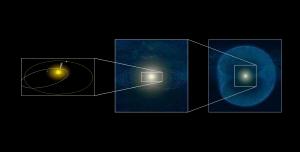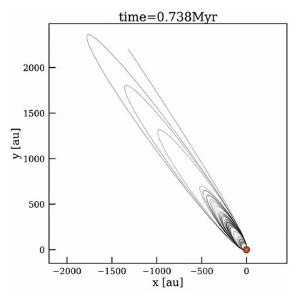Blog
Birth of a Cloud
7 June 2021
 ESA/AOES Medialab
ESA/AOES MedialabThere is a cloud of debris surrounding our solar system. It’s known as the Oort cloud, and it is the source of most of the comets in our solar system. It was first proposed by Jan Oort, as a way to explain why there were so many long-period comets, and why they can appear from almost any direction. It’s estimated that there are about 100 billion small icy bodies in the Oort cloud, spread throughout a sphere about 50,000 AU from the Sun. Through our studies of comets we’ve learned a great deal about the Oort cloud, but we still don’t fully understand how it came to be.
One of the more popular ideas is that the Oort cloud formed during the great migration of planets. According to the Nice model, for example, a gravitational resonance between Jupiter and Saturn drove Uranus and Neptune further from the Sun. This shift of planetary orbits cleared debris from the solar system. Some of it was thrown to the inner solar system causing the Late Heavy Bombardment, while most of it was scattered outward to form the Oort cloud. This makes sense, but a new study suggests that’s not how it formed.1
 Netherlands Research School for Astronomy
Netherlands Research School for AstronomyMost of what we understand about the origins of the Oort cloud comes from computer simulations. It takes a great deal of computing power to model the orbits of small bodies over millions of years, so most simulations look at the evolution of the Oort cloud in stages. This new work simulates the orbital evolution of small bodies from the early solar system to the Oort cloud as a single model, a process that spans billions of years.
What their simulation shows is that the Oort cloud did not form during a single, relatively short-lived period of the early solar system. The bodies of the Oort cloud aren’t even entirely from our solar system. Instead, the cloud has multiple sources. Part of it is remnant material from the Sun’s protoplanetary disk that has always been in the outer solar system. Part of the debris came from the inner solar system and was ejected outward by the larger planets.
But some of the Oort cloud’s debris from other solar systems. When the Sun was young it was part of a stellar nursery consisting of about a thousand stars. Material on the outer edge of nearby stellar systems was captured by the Sun’s gravity, and most of this material settled within the Oort cloud. Overall, this simulation suggests that the Oort cloud formed relatively late in the history of our solar system, and only entered its present form after the Sun had left its stellar nursery.
We now know that a few comets come from other star systems, but if this model is correct, even some of the local comets from the Oort cloud may extrasolar as well.
Zwart, Simon Portegies, et al. “Oort cloud Ecology II: The chronology of the formation of the Oort cloud.” arXiv preprint arXiv:2105.12816 (2021). ↩︎